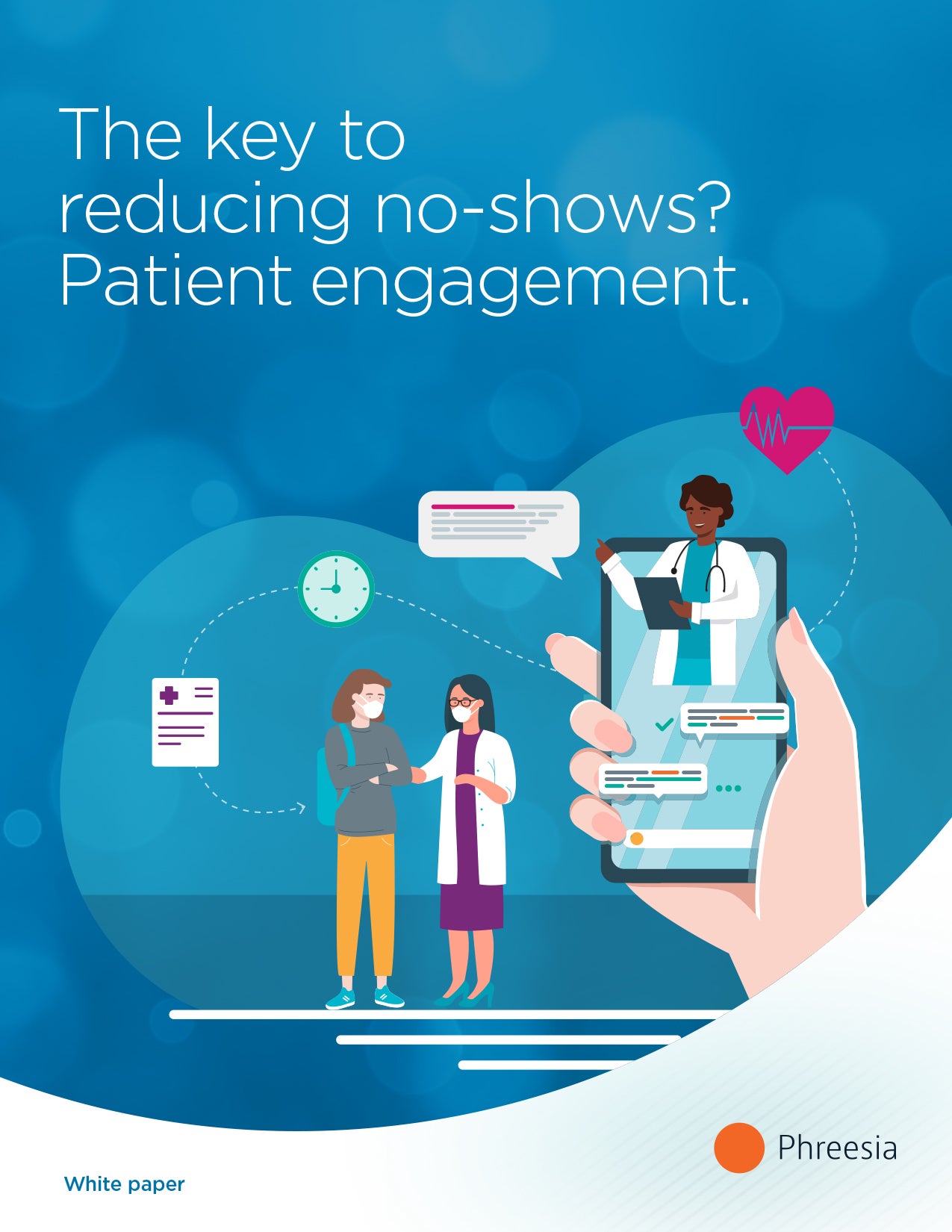Every healthcare organization struggles with patient no-shows. As many as 30% of patients may not show up for their appointments, creating operational and financial challenges that can ripple across an entire organization. In the U.S. alone, no-shows cost the healthcare industry billions of dollars every year between lost revenue and patient attrition.
For all these reasons and more, it is critical that healthcare organizations tackle no-shows head-on. This white paper outlines how positive, consistent patient engagement can minimize no-shows and offers concrete steps that healthcare organizations can take to ensure patients feel prepared and informed about their upcoming visit.
Read this white paper to learn about:
- The most common reasons that patients fail to keep their appointments, and how to address them
- Messaging and outreach strategies for reducing no-shows
- How to engage patients in their care without creating more work for staff
Click the image to open the white paper
The key to reducing no-shows? Patient engagement.
Executive Summary
Medical practices and health systems everywhere struggle with patient no-shows, an issue that has been deemed one of “most important problems faced by health centers” in today’s healthcare industry.i Why? Because when patients don’t keep their appointments, care suffers—and so does the bottom line of provider organizations that hope to serve them.
Patients fail to show for their appointments for a variety of reasons, some of which may not be preventable. But there are a number of tools that healthcare organizations can employ to ensure that patients are aware of their scheduled appointment and to confirm that they are planning to attend. Self-scheduling, frequent appointment reminders and consistent communication can help patients keep track of their appointments and avoid last-minute surprises. Automation can ensure that these proactive actions don’t put additional burden on staff.
In this white paper, we’ll share:
- The most common reasons why patients no-show and how to address those reasons
- Best practices for messaging and outreach that can prevent no-shows
- Strategies for reducing no-shows without adding to staff workload
No-shows can create challenges across your organization
As many as 30% of patients may not show up for their appointments, creating major gaps in their care and longer waits to see a clinician.ii In addition, when providers’ schedules aren’t kept full, the effects can ripple across the entire organization. In the U.S. alone, no-shows cost the healthcare industry billions of dollars every year between lost revenue and patient attrition.iii
***
But there is a better way: Engage patients before and after their visit (or no-show) with a more modern appointment scheduling strategy. Positive, consistent patient engagement minimizes no-shows because patients are more likely to show for appointments when they feel respected and valued while receiving care.iv
Why patients don’t show up
Many factors influence patient no-shows, and healthcare organizations have varying abilities to address those factors. Some challenges are related to the operations and structure of the healthcare organization itself, some are related to patients’ social determinants and access to care, and still others are unique to each patient. Here are some of the most common reasons that patients fail to keep their appointments, as reported in a study published in Risk Management and Healthcare Policy:v
- Forgetfulness: Sometimes patients simply forget about an appointment, especially if they scheduled it long ago. That’s why it’s important to send frequent appointment reminders and offer earlier appointments when available. Automating this process can reduce the burden on staff.
- Lack of urgency: Sometimes patients are too busy to focus on their health or may not see a medical need as urgent. Digital outreach and education about the risks of delaying care and the importance of preventive care can help motivate patients to act promptly.
- Fear or anxiety: It’s not uncommon for patients to worry about or be afraid of medical care or procedures. Staff can alleviate patients’ general anxiety about visiting the doctor by making themselves available via two-way patient chat to answer questions. Understandably, concerns about COVID-19 transmission have increased in-office no-shows, compelling providers to directly address this issue. vi Healthcare organizations must proactively communicate their COVID-19 policies and safety precautions to patients on an ongoing basis, as well as including their current protocols in all appointment reminders and confirmations.
- Language barriers: If patients don’t read English well, and the organization’s registration process and messaging are not available in other languages, they may not understand their instructions and fail to keep their appointment. Providing support for multiple languages not only ensures that patients show up on the right day at the right time, it also contributes to an improved, personalized care experience.
- Lack of reliable transportation or childcare: If patients don’t have transportation or childcare coverage, they may not be able to keep their appointment. It can be a challenge for health systems to effectively address social determinants of health like these, but bus vouchers, rideshare partnerships and flexible operating hours can help reduce the obstacles that keep patients from showing up. Providers can better predict which patients may need this support by screening every patient for social needs during the registration process.
- Inadequate insurance coverage or inability to pay: Patients may skip their appointment if their insurance doesn’t adequately cover a visit or procedure, or if they have concerns about being able to afford their share of its cost. Transparency is vital for overcoming this obstacle, and digital intake solutions can help. Encourage patients to submit their insurance information ahead of their appointment so that automated eligibility and benefits checks can be run before their visit. When staff are equipped with this information, they can reach out to patients before they come in and manage their expectations for the cost of care.
- Weather: Unfortunately, weather can be unpredictable and beyond anyone’s control. What healthcare organizations can control, however, is how they prepare for severe weather events. If weather conditions will make it difficult for patients to get to the facility, reach out via email or text message to ask them if they would like to reschedule their appointment or convert it to a telehealth visit. Bad weather can be a challenge for staff as well—if weather-related travel puts clinicians behind schedule, message those patients with upcoming visits to help them adjust their arrival time.
How to reduce no-shows by creating a patient-powered digital experience
Empower patients by letting them schedule their own appointments
Many healthcare organizations still schedule all of their patient appointments by phone. Appointment call centers can become overwhelmed in the process, leading to long hold times and a poor overall patient experience.
Online self-scheduling is a tech-enabled alternative that makes booking an appointment easy and convenient. Many scheduling tools allow patients to add their appointment to their calendar app, helping to ensure they don’t forget about their upcoming visit. Allowing patients to self-schedule not only minimizes no-shows but also reduces the administrative burden on staff. This means that patients will spend less time on hold if they do need to call their provider’s office, ultimately improving overall patient satisfaction, according to research published in the Journal of Medical Internet Research.vii
Send automated appointment reminders to reduce no-shows
Appointment reminders are critical to reducing no-shows—one study found that when parents of pediatric patients received a text message in addition to a phone call reminder, no-shows dropped by more than 14%.viii However, manually messaging or calling patients can be a huge burden on staff. Automating appointment reminders ensures that patients will receive consistent outreach—and frees up staff for more complex tasks.
Additionally, when several reminders are sent before an appointment, patients have multiple opportunities to either confirm or cancel their visit, which can prevent no-shows and last-minute cancellations. Reminding patients about upcoming appointments through text messages or email also helps to meet their growing expectations for tech-enabled healthcare services, with the added benefit of improving organizational efficiency.
Make sure that outreach messaging explicitly asks patients to confirm or cancel their appointment through a link in the email message or a text reply. Just as appointment self-scheduling is a best practice, so is online appointment “self-canceling.” If a patient must call during business hours to cancel an appointment, they may put it off until it’s too late.
Convert upcoming visits to telehealth to prevent missed appointments
While high no-show rates for in-person are concerning for patient outcomes—as well as the organization’s bottom line—data shows that virtual visits have the potential to provide relief. A Telemedicine and e-Health study conducted between March and May 2020 found that telehealth visits at a primary and specialty care clinic had a no-show rate of just 7.5%, four times lower than the average in-office no-show rate prior to the pandemic.6 Those rate differences contrasted even more sharply during the height of the pandemic, according to the study.
When sending appointment reminders or responding to cancellations, offer a telehealth visit if a patient says he or she can’t make it to the office, or if they express concerns about COVID-19 risks. Providing a virtual-appointment alternative not only helps that patient get needed care, it ensures retained revenue for the patient’s visit.
Automate the waitlist process to quickly refill canceled appointments
No-shows and last-minute cancellations can’t always be prevented, but they can addressed more efficiently. Staff may spend hours each day calling patients to fill cancellations, but automation can accomplish that task in a matter of minutes without requiring any staff effort.
An automated schedule-management tool can turn cancellations into opportunities. When a patient cancels a visit, the tool identifies other clinically relevant patients with upcoming appointments and automatically sends them a text message offering the earlier, reopened appointment slot. The first patient to reply gets that appointment—no waitlist sign-ups, apps, portals or staff work required.
Keep patients engaged with prompt follow-up after they cancel or fail to show up for an appointment
Follow-up after a cancellation or a no-show is important, not only for patient retention, but also to ensure that patients’ pressing medical needs are met before they get worse. Contacting patients within 24 hours of a missed appointment can keep them engaged in their care. Make sure that follow-up messages convey empathy and understanding, emphasizing that their provider wants to attend to their unaddressed medical needs as soon as possible.
Technology and templated messaging can help automate this process and motivate patients to reschedule promptly by offering upcoming timeslots for self-scheduling or allowing them to make an appointment request with a quick click.
Reducing no-shows is possible when patients are empowered with the right tools. That’s why it’s so important for provider organizations to put innovative technology in the hands of patients—before, during and after their visit—so that they can take an active role in their own care. Learn how Phreesia can help streamline the appointment process and help providers avoid empty timeslots.
END NOTES
- “Patient No-Show Prediction: A Systematic Literature Review,” Entropy, June 22, 2020.
- “No-shows in appointment scheduling – a systematic literature review,” Health Policy, April 2018.
- “No-shows cost health care system billions,” Pittsburgh Post-Gazette, Feb. 23, 2013.
- “Why We Don’t Come: Patient Perceptions on No-Shows,” Annals of Family Medicine,
November 2004. - “Evaluating the Impact of Patient No-Shows on Service Quality,” Risk Management and
Healthcare Policy, June 4, 2020. - “Reduced No-Show Rates and Sustained Patient Satisfaction of Telehealth During the
COVID-19 Pandemic,” Telemedicine and e-Health, December 2021. - “Web-Based Medical Appointment Systems: A Systematic Review,” Journal of Medical Internet
Research, April 2017. - “Text Message Reminders Increase Appointment Adherence in a Pediatric Clinic: A
Randomized Controlled Trial,” International Journal of Pediatrics, Dec. 29, 2016.






